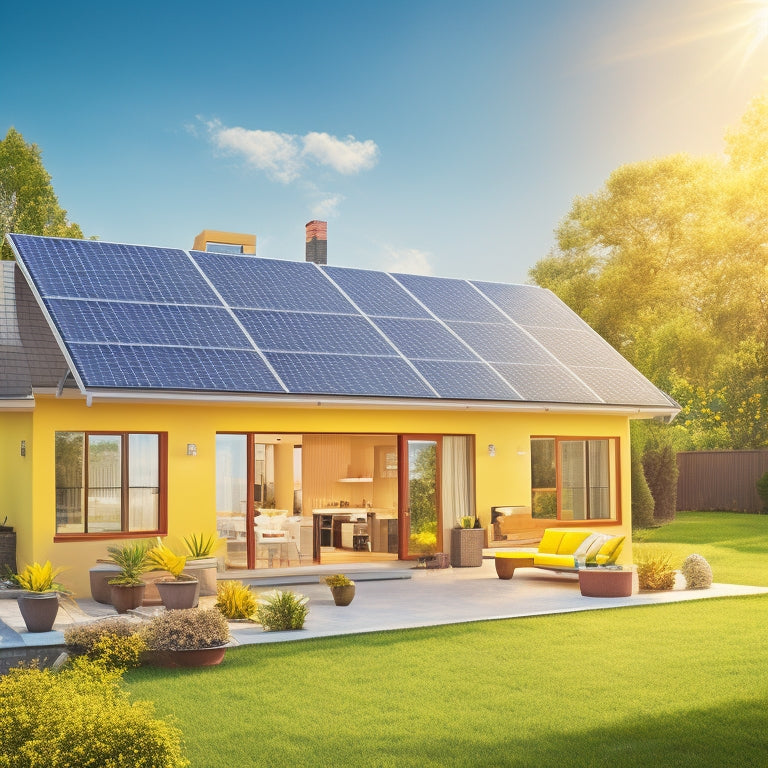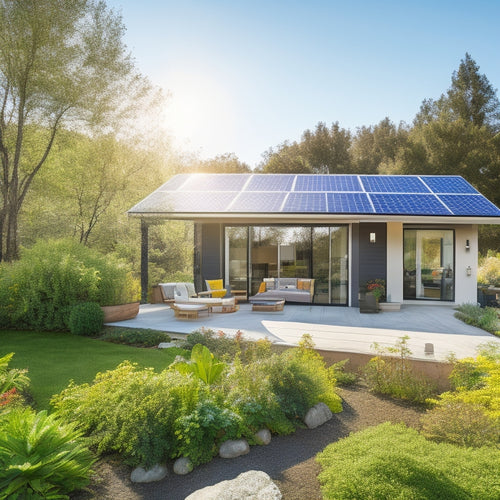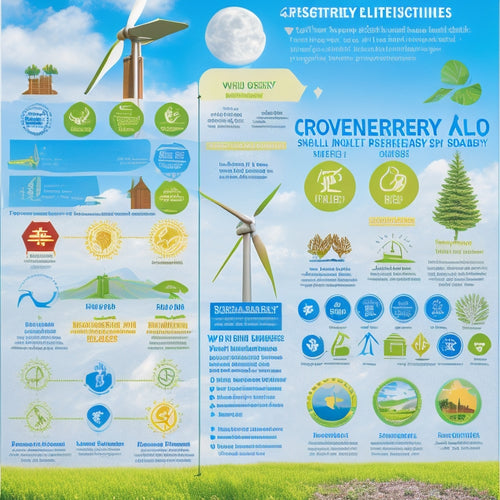
Harnessing Solar Electricity for Your Home in 5 Steps
Share
You'll utilize solar electricity for your home in 5 steps. First, evaluate your home's solar potential by examining its orientation, shading, and energy production impact. Next, choose the right solar panel system by balancing cost and efficiency, considering factors like durability and energy output. Then, plan your installation and permits, ensuring compliance with local building codes and evaluating your roof's structural integrity. After that, install and connect your system, securing panels on your roof and connecting them to an inverter and net meter. Finally, monitor and maintain your system's performance, identifying potential issues and areas for improvement, and you'll be on your way to harvesting clean energy from the sun.
Key Takeaways
- Assess your home's solar potential by evaluating roof orientation, shading, and obstacles to determine viability of a solar electric system.
- Choose the right solar panel system by balancing cost, efficiency, and durability, considering factors like energy efficiency and weather exposure.
- Plan the installation by conducting a site evaluation, reviewing local building codes, and ensuring roof structural integrity and electrical wiring routes.
- Install and connect the system by securing solar panels, converting DC to AC power, and measuring energy production and grid feedback.
- Monitor and maintain the system's performance by tracking energy production, identifying potential issues, and performing regular maintenance tasks like cleaning and inspecting panels.
Assess Your Home's Solar Potential
Before investing in a solar electric system, it's essential to assess your home's solar potential to determine if it's a viable option.
You'll need to evaluate your home's solar orientation, which refers to the direction your roof faces. A south-facing roof receives the most sunlight, making it ideal for solar panels. East- and west-facing roofs are also suitable, but north-facing roofs may not be suitable due to limited sunlight.
Next, conduct a shading analysis to identify any obstacles that may block sunlight from reaching your solar panels. This includes nearby trees, buildings, and even your own roof's features, such as chimneys or skylights.
You'll need to assess the intensity and duration of shading throughout the day to determine its impact on your solar energy production. By analyzing your home's solar orientation and shading, you'll be able to determine whether a solar electric system is a viable option for your home and optimize its performance if you decide to install one.
Choose the Right Solar Panel System
Now that you've assessed your home's solar potential, you're ready to investigate the various solar panel systems available. With so many options on the market, it's vital to understand the different types of solar panels and their energy efficiency.
| Solar Panel Type | Energy Efficiency | Durability |
|---|---|---|
| Monocrystalline | 15-20% | High |
| Polycrystalline | 12-15% | Medium |
| Thin-Film | 7-14% | Low |
When choosing a solar panel system, consider the following factors:
Energy efficiency is a significant factor, as it directly affects how much power your system can generate. Monocrystalline panels are the most efficient, but also the most expensive. Polycrystalline panels offer a balance between efficiency and cost. Thin-film panels are the least efficient but are often the most affordable.
Durability is also important, as solar panels are exposed to harsh weather conditions. Look for panels with a high durability rating to guarantee your system lasts for years to come.
Plan Your Installation and Permits
Your solar panel system is selected, and it's time to plan the installation and obtain the necessary permits. This step is vital to guarantee a smooth and hassle-free installation process.
Before the installation begins, a site evaluation will be conducted to assess your home's energy efficiency and identify potential issues. This evaluation will help determine the best placement and orientation of your solar panels.
Here are some key factors to reflect on when planning your installation and securing permits:
- Review your local building codes and ordinances to determine permit requirements
- Confirm your roof is structurally sound and can support the weight of the solar panels
- Identify any potential shading issues from trees or nearby structures
- Determine the best route for electrical wiring and connections
- Verify that your homeowner's association (if applicable) allows solar panel installations
Install and Connect Your System
With the planning and permitting process complete, the installation of your solar panel system is ready to begin. Your chosen installer will arrive at your home with all necessary system components, including solar panels, inverters, mounting hardware, and electrical connections.
They'll start by preparing your roof, verifying it's structurally sound and clear of debris. Next, they'll install the mounting system, securely attaching the solar panels to your roof. The installation process typically takes several days to a week, depending on the size of your system.
Once the panels are in place, the installer will connect them to the inverter, which converts DC power into usable AC power for your home. They'll also install a net meter, which measures the electricity your system produces and feeds back into the grid.
After connecting all system components, the installer will test the system to confirm it's functioning correctly and efficiently. Finally, they'll provide you with documentation and instructions on how to operate and troubleshoot your new solar panel system.
Monitor and Maintain Performance
Regularly, your solar panel system will require monitoring and maintenance to guarantee peak performance and longevity.
This is vital in confirming you get the most out of your investment and enjoy a steady supply of clean energy.
Performance tracking is essential to identify potential issues before they escalate into major problems.
You'll want to keep tabs on your system's energy production, monitoring its performance against the expected output.
This will help you detect any deviations and take corrective action promptly.
To secure optimal performance, you'll need to perform regular maintenance tasks, including:
- Inspecting your panels for dirt, debris, or damage
- Cleaning your panels regularly to maintain their efficiency
- Verifying that all connections are secure and functioning correctly
- Checking your system's electrical output to confirm it's within the expected range
- Reviewing your system's overall performance to identify areas for improvement
Frequently Asked Questions
Can I Install Solar Panels on My Own to Save Money?
You can attempt a DIY installation to save money, but it's essential to take into account your electrical knowledge and local building codes to avoid costly mistakes that might negate the cost savings you're hoping to achieve.
How Long Does a Typical Solar Panel Warranty Last?
You'll typically find that a solar panel warranty lasts around 25-30 years, covering defects and performance guarantees, ensuring your system operates at peak efficiency throughout its expected 30-40 year solar panel lifespan, with some manufacturers offering extended warranty coverage.
Are Solar Panels Affected by Different Weather Conditions?
Like a storm cloud casting a shadow, weather conditions can impact your solar panel's performance. You'll find that solar panel efficiency dips in extreme temperatures, humidity, and shading, but don't worry, most panels are designed to withstand Mother Nature's tantrums.
Can I Sell Excess Energy Back to the Grid?
You can sell excess energy back to the grid through net metering, which allows you to offset your consumption and receive credits; energy buyback policies also enable you to profit from your surplus energy, putting money back in your pocket.
Do Solar Panels Increase My Home's Value?
As you bask in the radiant glow of solar panels, you'll reap a brighter benefit: increased home value. Your investment in clean energy won't just power your home, but also enhance its worth, thanks to solar panel benefits like long-term home energy savings.
Conclusion
You've taken the first step towards bathing your home in the warm glow of renewable energy. As the sun's rays dance across your rooftop, your new solar panel system will silently convert them into a bounty of electricity. With each kilowatt-hour, you'll be weaving a fabric of sustainability, reducing your carbon footprint, and saving on your energy bills.
Related Posts
-

Green Home Improvements Using Solar Power
Investing in solar power alters your home into a sustainable haven while slashing energy costs. You can greatly reduc...
-

Renewable Energy Certifications for Businesses
Renewable energy certifications are essential for your business, showcasing your commitment to sustainability and enh...
-

Solar Power Backup Solutions During Outages
Solar power backup solutions guarantee you have reliable energy during outages, providing essential power when the gr...


